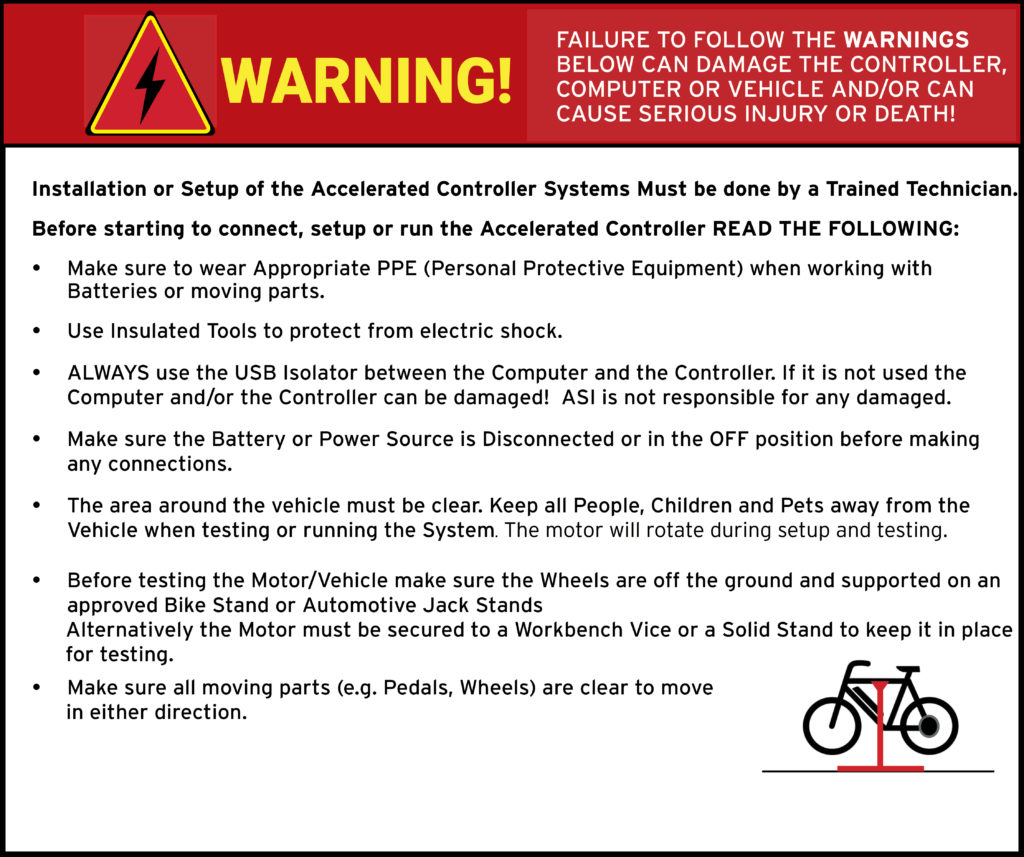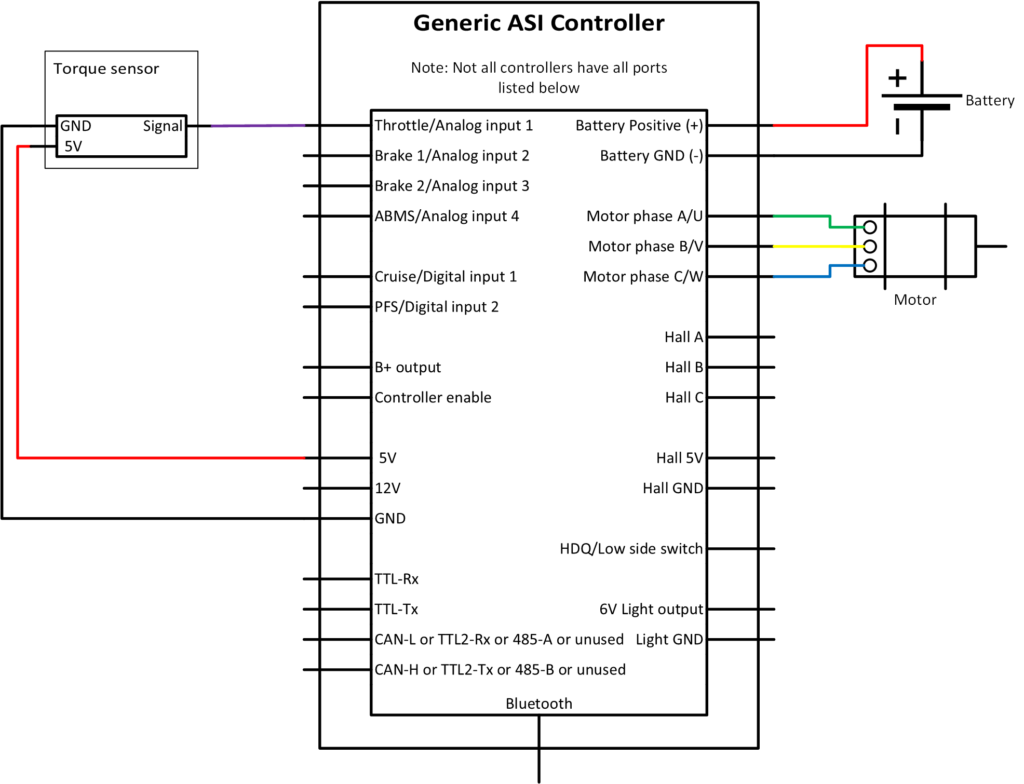Axle Torque
Table of contents
- Introduction
- Warnings
- Required tools
- Supported torque sensor types
- Torque sensor input & wiring
- Axel torque sensor setup
- Configuration parameters
- Troubleshooting
1 – Introduction
A torque sensor measures the force a rider is applying to the pedals and commands a proportional amount of motor assistance. Compared with pedal cadence only, where the output power is decoupled from pedal input power, a torque sensor ties the motor output power to the input pedal force. This provides an amplified analog bike ride feel.
Different torque sensor types exist, axle type and the more common pedal type.
- Pedal torque sensors refer to sensors that have integrated torque and cadence sensor. The cadence sensor needs to be configured to actually start and stop a vehicle. The motor will not be enabled until the pedals are rotated. Pedal torque sensors need the specific offset to be programmed.
- Axle torque sensors or any torque sensor without an integrated pedal sensor need to be configured to not start a vehicle without pedalling. In the absence of a cadence sensor, the vehicle has to use the rolling start feature so that the motor will not be enabled until the vehicle is at a minimum speed (this assumes the pedal got it to this speed). We automatically measure axle torque sensors offset during power-up. This assumes the user is not putting pressure on the pedals during power-up.
This section will guide you through setting up your axle torque sensor. See Pedal Torque to set up your pedal cadence torque sensor.
2 – Warnings

ATTENTION – Indicates a step or procedure required before proceeding to the next step or page.
CAUTION – Indicates a potentially hazardous situation which may result in minor injury or product damage.
WARNING – Indicates a Hazardous situation which if not avoided will result in serious injury/death to person(s) or damage to product and/or equipment.
TIP – Indicates a helpful Tip to make things easier and faster.
3 – Required tools
- Appropriate personal protective equipment (PPE) as required(e.g. Safety glasses, gloves, etc.)
- ASI BACDoor™ software
- 22 AWG Wire strippers (eMobility)
- 18 AWG Wire strippers (high power)
- Vehicle stand, or motor stand to securely support the vehicle or motor drive wheel off the ground for testing (e.g. Bike stand, jack stands, etc.)
4 – Supported torque sensor types
The following axle torque sensor types are supported:
- 0-5V analog signal
5 – Torque sensor input & wiring
A torque sensor typically has 3 wires: 5V or 12V power, GND, and a signal wire. The signal must be connected to Throttle/Analog input 1.
If the torque sensor is a pedal type, the power and ground will be shared with the integrated cadence sensor.

6 – Axel torque sensor setup
WARNING – Ensure vehicle is secured in-case the motor engages unexpectedly while manually configuring your pedal sensor.
TIP – Make a backup copy of the parameter file often by saving it to file as shown before. It can be sent to ASI for support or you can revert if strange behaviour occurs.
With the axle torque sensor connected to Throttle/Analog input 1 on the controller:
- Set the Control command source to 0 (serial stream) to prevent the motor from accidentally engaging while setting up the torque sensor.
- Enable the eBike flag, bit 10 under communications configuration vector.
- Poll throttle voltage and apply load to the torque sensor to verify the throttle voltage is wired correctly and responding to changes in torque input.
- Set the Pedal sensor type to 5 (Axle torque).
- Set gains Axle torque sensor 1, Axle torque sensor 2 and Axle torque sensor 3.
- Set the Pedalec power gain to 1 for 1:1 power gain relative to measured torque to start testing with.
- Set the Control command source to Pedal sensor or throttle OR pedal sensor, as appropriate.
- Check if the torque output of the sensor configured and is working properly. Add a small amount of resistance to the motored wheel either using a bike trainer or the brakes and then pedal in the forward direction at as constant a cadence as possible. Observe that the average pedal torque increases/decreases with the addition/subtracting of resistance provided by the brake.
Torque sensor fine-tuning of feel and adjustment parameters are explained in Section 4 – Ride Performance: Axle torque sensor assist.
7 – Configuration parameters
Command inputs configuration
The following parameter is key to configure the main method by which a vehicle is commanded to move.
| Name | Description | Units | Address |
| Control command source | 208 |
Pedal input configuration
The minimum information required to set up a pedal sensor is the sensor type and the pulses per revolution.
| Name | Description | Units | Address |
| Pedal sensor type | 211 | ||
| Torque sensor gain | 183 | ||
| Pedalec power gain | 179 | ||
| Axle torque sensor offset voltage | 349 | ||
| Torque sensor offset | 182 | ||
| Pedalec torque symmetry | 178 |
Torque input parameter
This value can be monitored to ensure your torque sensor is wired correctly and the controller is measuring the input torque.
| Name | Description | Units | Address |
| average pedal torque | 332 |
Command levels
The motor command levels can be monitored with the parameters below.
| Name | Description | Units | Address |
| torque command | 335 | ||
| torque reference | 336 |
eBike flags
eBike flags are a convenient parameter to monitor when developing a drive system. They indicate what the controller state is when any input is activated.
| Name | Description | Units | Address |
| eBike flags | 327 |
8 – Troubleshooting
8.1 – I have no motor assistance?
8.1.1 – Vehicle maximum speed not set in speed limited modes
If you are in a speed-limited Speed regulator mode (e.g.: speed or torque mode with speed limiting), you must set your Vehicle maximum speed (Race mode PAS max speed) and Vehicle maximum speed (Street mode PAS max speed) to non-zero values accordingly.
8.1.2 – Rated motor power not set for alternative power modes
Set Rated motor power (Race mode PAS power) and Rated motor power (Street mode PAS power) to your rated motor power for modes used.
8.1.3 – Negative torque
Some sensors voltage drops with applied torque, for these sensors the Pedalec torque gain value must be negative to calculate a resulting positive average pedal torque. Commanding assistance from the motor.
8.1.4 – Assist level
If you have chosen an Assist mode source other than 0 (none), set it to 0 and verify whether you have any motor assistance or not. If you do, likely the assist mode source is not set up correctly and is limiting some or all power and enforcing a speed limit below your testing threshold.
8.1.5 – Negative cadence
If you are getting a negative cadence when pedalling forward and are getting a positive cadence and likely motor assistance when pedalling in reverse, you’ve chosen the wrong pedal cadence sensor type. The solution is to choose the reverse or if reverse chose the normal pedal sensor type. I.e. if you chose single Hall reverse and your cadence is negative, chose single Hall.
8.1.6 – Ebike flag not set in communications configuration vector
Enable communications configuration vector bit 10 (Enable Ebike) to enable Pedal sensors.
